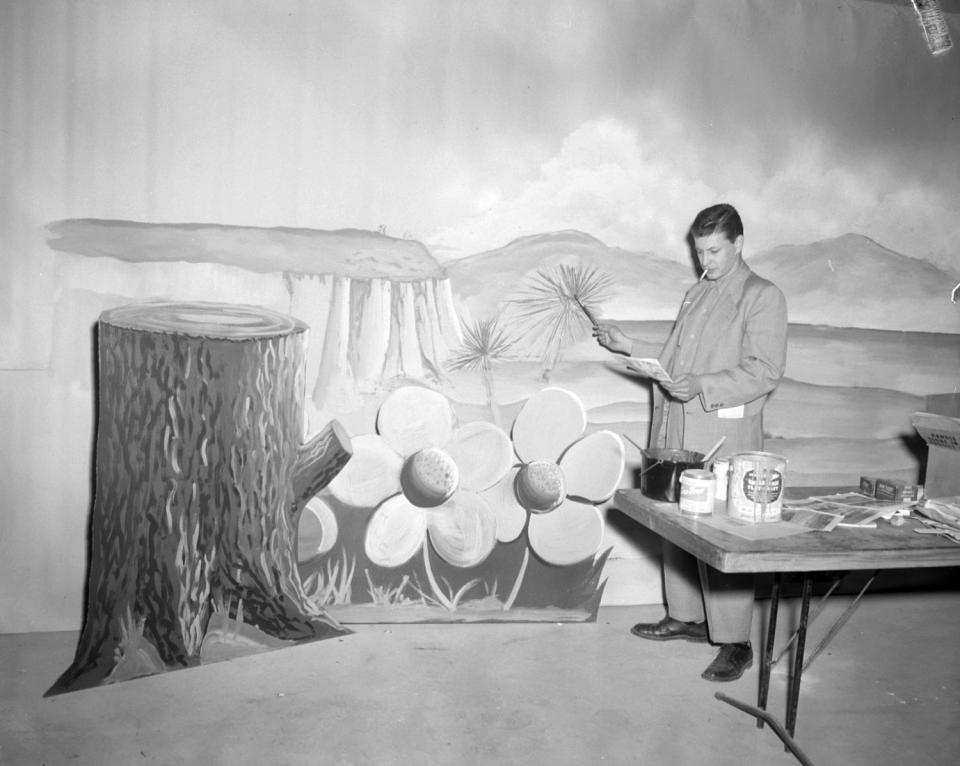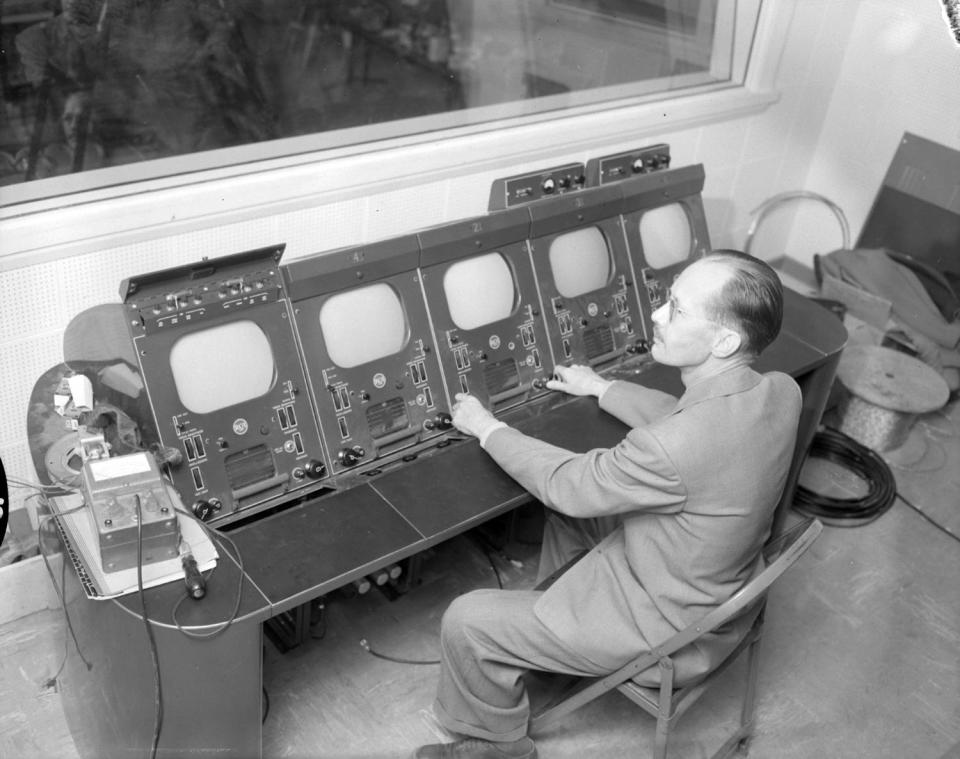'Wonders of entertainment,' television arrived in El Paso in 1952: Trish Long
Dec. 14 will mark 70 years of television in El Paso. KROD-TV, the forerunner of Channel 4-KDBC, went on the air at 1 p.m. with no network affiliation.
From a Dec. 14, 1952, special section on the arrival of TV in El Paso:
KROD-TV will go on the air at 1:30 p.m. Sunday.

Officials and employees worked feverishly
And, barring unforeseen technical mishaps, El Paso television viewers will see conventional programs until approximately 10 p.m.
Harried officials and employees of the new station worked feverishly Saturday completing final arrangements for a history-making day for the El Paso area.
Val Lawrence, president and general manager of the station, said that technical difficulties might possibly hamper operations temporarily.
“Some of our equipment has not been thoroughly tested,” he said. “Our first telecasts will be made from a temporary antenna which will not give the full range of coverage we will have soon.”
The station's new antenna, located atop a tower on the crest of Mount Franklin, has not been completed. It probably will be placed in service by the middle of the week, Lawrence said.
The temporary antenna should carry the KROD-TV signal to all El Paso areas, he added.
More:From helicopter to firetruck, Santa's arrival in Northeast El Paso: Trish Long
Don't be irked over first pictures
He urged TV set owners not to become irked at their dealers or installation men if the first pictures received are not clear. Such trouble probably will be in the transmission and will be corrected quickly, he said.
The 1:30 to 10 p.m. schedule will prevail on Sundays, according to present plans, Lawrence said. Weekday telecasts will be from 4 p.m. to 11 p.m.
Roderick Broadcasting Corp., operator of radio station KROD, obtained its television station permit in July from the Federal Communications Commission. It was the first permit granted in El Paso.
More than $600,000 and over two years of planning have gone into the task of building KROD-TV. Actual construction of the TV addition to the station's studio began in September. Work on the road up Mount Franklin to the antenna tower site started Sept. 22.
New wonders
Another article that appeared in a special TV section of the Times stated, "The lifting of the World War II ban on the construction of television stations by the FCC now allows KROD-TV to bring into operation a television station which cost approximately $500,000 and will bring to an estimated 215,000 persons the new wonders and entertainment of TV."
Bernie Bracher, the station's program director, promised variety in the 50-hour-a-week broadcasts.
Present plans call for at least 40 percent of the programs carried by KROD-TV to be produced locally, and they will range from news through sports, variety, dramatic, and other forms of entertainment for local viewers.
Of particular interest to sports fans will be an hourlong wrestling show which will be produced in the studios of KROD-TV.
An actual wrestling ring will be constructed in the studios, and local sports fans will not only get a commentary on various holds and the art of wrestling, but they will see actual matches.
The show will be held once a week.

Red Brown's Ranch
El Paso’s own Red Brown and his wife Anna Lee will be seen over the KROD-TV screen in two shows. Red and Anna Lee will be the top performers in “Red Brown’s Ranch,” which will be produced five days a week for 30 minutes and will be built mainly around studio guests.
Red and Anna Lee will have as their guest on each program the boys and girls whose birthdays fall on that particular day, with Red and Anna Lee filling in with their own style of singing and clowning.
Red and Anna Lee also will be seen on Channel 4 over KROD-TV in their own program of Western and hillbilly music, which is well known to El Paso fans.
Another veteran El Paso performer who will be seen regularly over Channel 4 and KROD-TV will be Lois Kibbee and her program for women.
More:Moms who had four or more sons serving US in WWII celebrated: Trish Long
Steepest Road In El Paso County leads to KROD’s television tower
Before the broadcast of the first television signal could be accomplished, a tower was installed on the Mount Franklin:
El Paso’s newest and steepest road leads to the new KROD television tower on the crest of historic Mount Franklin.
The road was engineered by the Lance Engineering Co. of El Paso and built by the Pecos Valley Construction Co. of Carlsbad. Cost of the road alone is estimated at $36,000.
The road, according to engineer Paul Lance, is typical of a road to a mountain mine in the Southwest. It is definitely not for public traffic, and in fact can only be traversed by truck or jeep.
Before construction of the road was undertaken, Lance surveyed the possibility of hauling materials for the tower and the house for the men who serve it, to the top of Mount Franklin by helicopter. He also seriously considered using power-driven cables to carry the materials to the crest.
More than 2,000 square yards of rock were cleared at the climax of the road to level the mountain crest for construction of the television tower and adjacent building.
New home decorating styles
There also was talk of how television would change home-decorating styles:
A visit to your local stores will reveal chairs, sectionals, and tables that glide easily on wheels or casters ‒ chairs that look like ordinary armchairs but swivel around in any direction ‒ enormous ottomans that conceal four little ottomans under their oversized, upholstered tops ‒ tables and cabinets with swivel tops so that the television set may be turned to face any part of the room.
There are also cabinets that hold folding chairs which are handy to have when all the neighbors descend upon your living room to see an especially popular program ‒ lightweight armless chairs with cutout back rails so that they may be easily moved around ‒ and many curved sectional sofas which are designed to seat six or seven television fans.
You'll find small, individual folding tables to hold food and beverages, and many of these may be stacked together when not in use. All of these innovations are brand new ‒ smartly styled in modern, 18th century, or Provincial designs ‒ and wonderfully practical for television fans.
Many of the stores are showing model television rooms featuring this exciting new merchandise and illustrating proper room arrangements for greater television enjoyment.
Trish Long may be reached at tlong@elpasotimes.com or 915-546-6179.
This article originally appeared on El Paso Times: 'Wonders of entertainment,' TV arrived in El Paso in 1952: Trish Long

